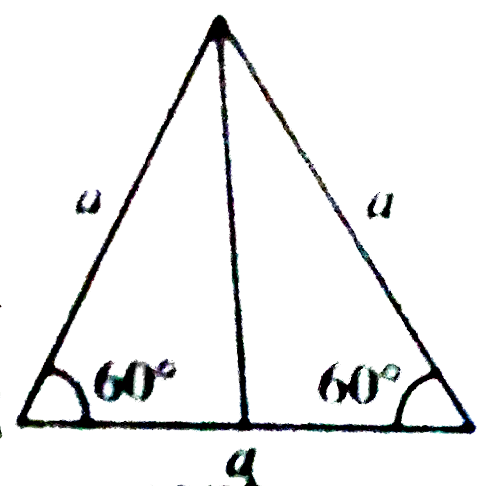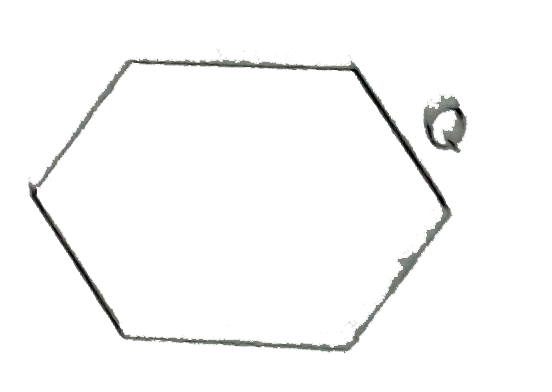A uniform conducting wire of length 12a and resistance R is wound up as a current carrying coil in the shape of (i) an equilateral triangle of side a, (ii) a square of sides a and, (iii) a regular hexagon of sides a. The coil is connected to a voltage source V0. Find the magnetic moment of the coils in each case.
To solve the problem of finding the magnetic moment of a current-carrying coil in the shape of an equilateral triangle, a square, and a regular hexagon, we will proceed step by step.
Step 1: Determine the Number of Turns for Each Shape
The total length of the wire is given as 12a.
1. Equilateral Triangle:
- The perimeter of the triangle is 3a.
- Number of turns n for the triangle:
n=Total length of wirePerimeter of triangle=12a3a=4
2. Square:
- The perimeter of the square is 4a.
- Number of turns n for the square:
n=12a4a=3
3. Regular Hexagon:
- The perimeter of the hexagon is 6a.
- Number of turns n for the hexagon:
n=12a6a=2
Step 2: Calculate the Current I
The current I flowing through the coil can be calculated using Ohm's Law:
I=V0R
Step 3: Calculate the Area A of Each Shape
1. Equilateral Triangle:
- Area A of an equilateral triangle with side a:
A=√34a2
2. Square:
- Area A of a square with side a:
A=a2
3. Regular Hexagon:
- Area A of a regular hexagon with side a:
A=3√32a2
Step 4: Calculate the Magnetic Moment M for Each Shape
The magnetic moment M is given by the formula:
M=nIA
1. Equilateral Triangle:
- Substitute n, I, and A:
Mtriangle=4⋅(V0R)⋅(√34a2)=V0√3Ra2
2. Square:
- Substitute n, I, and A:
Msquare=3⋅(V0R)⋅a2=3V0Ra2
3. Regular Hexagon:
- Substitute n, I, and A:
Mhexagon=2⋅(V0R)⋅(3√32a2)=3√3V0Ra2
Final Results
- Magnetic Moment of Equilateral Triangle:
Mtriangle=V0√3Ra2
- Magnetic Moment of Square:
Msquare=3V0Ra2
- Magnetic Moment of Regular Hexagon:
Mhexagon=3√3V0Ra2
The total length of the wire is given as 12a.
- The perimeter of the triangle is 3a.
- Number of turns n for the triangle:
n=Total length of wirePerimeter of triangle=12a3a=4
- The perimeter of the square is 4a.
- Number of turns n for the square:
n=12a4a=3
- The perimeter of the hexagon is 6a.
- Number of turns n for the hexagon:
n=12a6a=2
The current I flowing through the coil can be calculated using Ohm's Law:
I=V0R
1. Equilateral Triangle:
- Area A of an equilateral triangle with side a:
A=√34a2
- Area A of a square with side a:
A=a2
- Area A of a regular hexagon with side a:
A=3√32a2
The magnetic moment M is given by the formula:
M=nIA
- Substitute n, I, and A:
Mtriangle=4⋅(V0R)⋅(√34a2)=V0√3Ra2
- Substitute n, I, and A:
Msquare=3⋅(V0R)⋅a2=3V0Ra2
- Substitute n, I, and A:
Mhexagon=2⋅(V0R)⋅(3√32a2)=3√3V0Ra2
- Magnetic Moment of Equilateral Triangle:
Mtriangle=V0√3Ra2
Msquare=3V0Ra2
Mhexagon=3√3V0Ra2
Topper's Solved these Questions
- MOVING CHARNGES AND MAGNETISMBOOK - NCERT EXEMPLAR ENGLISHCHAPTER - MOVING CHARNGES AND MAGNETISMEXERCISE - Short Answer Type Question
6 Videos
- MAGNETISM AND MATTER BOOK - NCERT EXEMPLAR ENGLISHCHAPTER - MAGNETISM AND MATTER EXERCISE - All Questions
24 Videos
- NUCLEIBOOK - NCERT EXEMPLAR ENGLISHCHAPTER - NUCLEIEXERCISE - Long answer type question
10 Videos
Similar Questions
A uniform conducting wire of length 18a and resistance R is wound up as current carrying coil in the shape of a regular a hexagon of sides a. If the coil is connected to a voltage source V0, then the magnetic moment of coil is

View SolutionA uniform conducting wire of length length 10a and resistance R is wound up into four turn as a current carrying coil in the shape of equilateral triangle of side a. If current I is flowing 4 through the coil then the magnetic moment of the coil is

View Solution
Knowledge Check
An equilateral triangle of side length l is formed from a piece of wire of uniform resistance. The current I is as shown in figure. Find the magnitude of the magnetic field at its centre O.
 A√3μ0I2πlB3√3μ0I2πlCμ0I2πlDzero
A√3μ0I2πlB3√3μ0I2πlCμ0I2πlDzero
A wire shaped to a regular hexagon of side 2cm carries a current of 2A. Find the magnetic field at the cetre of the hexagon.
View SolutionA wire shaped to a regular hexagon of side 2cm carries a current of 2A. Find the magnetic field at the cetre of the hexagon.
View SolutionA loop in the shape of an equilateral triangle triangle of side a carries a current I as shown in the figure.Find out the magnetic field at the centre C of the triangle.
View SolutionA regular hexagone of side a. A wire of length 24 a is coiled on that hexagone. If current in hexagone is I, then find the magnetic moment.

View SolutionA square loop OABCO of side of side l carries a current i. It is placed as shown in figure. Find the magnetic moment of loop.

View SolutionA square loop OABCO of side of side l carries a current i. It is placed as shown in figure. Find the magnetic moment of loop.

View SolutionAn equilateral triangle of side length l is formed from a piece of wire of uniform resistance. The current I is as shown in figure. Find the magnitude of the magnetic field at its centre O.

View Solution
